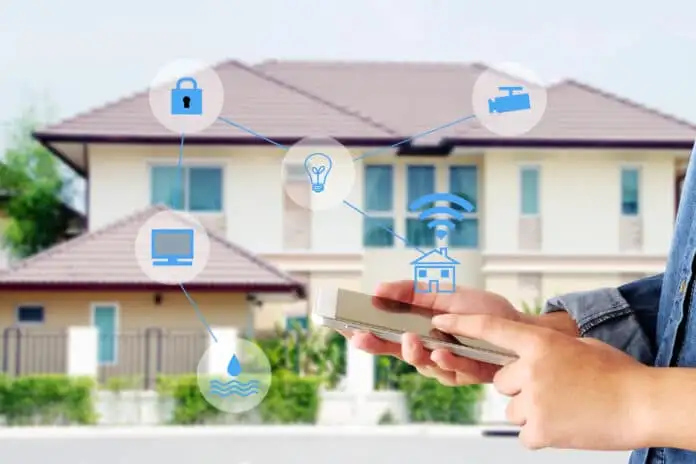Smart homes are becoming increasingly popular worldwide due to the convenience and ease they offer owners. Different interconnected devices work together to form a “smart” eco-system for homeowners that automate tasks and increase the simple enjoyment of living in a home. However, this connected nature can also become a cybersecurity risk if appropriate controls are not implemented. In this article, we will go over some of the critical risks and the measures to take to protect the smart devices present in your home.
Smart Home Cybersecurity
Smart homes are designed to make lives easier and more comfortable, with smart devices automating various tasks and catering to a person’s lifestyle. However, as with any connected device, security vulnerabilities can be present that cybercriminals can exploit to carry out malicious activities such as controlling devices, stealing personal information, and even physical theft. It is essential to know about these threats and take proactive measures to protect yourself before you become a victim of these attacks.
How to secure your Smart Home
When securing a smart home, good security practices are similar to securing a business. The difference is that it is your home you are securing instead of your workplace. It is crucial to create awareness in your household and educate them on good security practices such as not sharing passwords, securing their devices, and avoiding suspicious attachments or links in their emails. You and your family should also know whom to contact if they feel something suspicious is happening within your home. There is also no harm in contacting cybersecurity professionals for help if you need further help to secure your home environment and educate yourself on good practices.
In addition, other good security practices that can be taken are:
1- Ensure smart devices are from reputable sources
Smart Devices should always be purchased from reputable sources, not cheaper alternatives. Reputable names mean your devices will get regular updates to security issues and be better supported overall. Your smart devices form the foundation of your smart home and must be treated with the same importance. Make sure your devices are getting regular updates and sign up for any alerts so that you are aware of any critical patches as they are released
2 – Put in a strong password foundation
Smart devices often come with default passwords which should be changed as soon they are up and running in your home. Most of these default passwords are available online and can open the front door for attackers. Make sure you choose strong and complex passwords which cannot be easily guessed. If your devices support Multi-Factor Authentication (MFA), then enable the same to get another layer of security on top of your passwords/
3 – Sign up for alerts
Smart Devices can receive alerts for suspicious or sensitive alerts (such as when a security setting is changed). Do not leave these alerts dormant and turn them on so you are aware if any changes are done without your knowledge. Many Smart Devices come with security companion tools that can be enabled to provide additional functionality for an extra cost.
4 – Harden your smart devices
Smart Device manufacturers often provide best practice guides on configuring your smart device. Go through the same and see which settings/services are needed and which can be disabled. This greatly reduces the attack surface of your smart home.
5 – Secure your Wifi network
Smart Homes typically rely on your home’s WiFi network; hence the same must also be secured from attack. Cybercriminals can use a weak Wifi network to “piggyback” onto your Smart Home network hence protecting the same is crucial. Following these best practices at a minimum.
- Harden your Wifi router passwords and follow the practices we discussed earlier, e.g., strong passwords, hardening, updates, etc.
- Use Virtual Private Networks (VPN) to add encryption to your network communications. This can come in handy if you regularly access your smart home remotely.
- Harden your devices via firewalls and anti-malware solutions to prevent malware and other unauthorized activity. Make sure they regularly scan your environment for suspicious activity.
Conclusion
Smart homes are becoming increasingly familiar with each passing year, along with cyberattacks targeting them. Awareness of these attacks and implementing security controls at multiple layers means you can enjoy the comforts of your smart home without worrying about your privacy and safety.
FREQUENTLY ASKED QUESTIONS
What are the most common cybersecurity risks for smart homes?

The most common cybersecurity risks for smart homes include unauthorized access to devices and networks, data breaches, malware infections, and ransomware attacks. Hackers may exploit security vulnerabilities in smart devices to gain control, access personal data, or cause disruptions.
Can hackers take control of my smart home devices?

If your smart home devices have security vulnerabilities or are not adequately protected, hackers can exploit these weaknesses to gain control of your devices. To prevent this, ensure you purchase devices from reputable brands, keep the firmware and software up-to-date, and follow the cybersecurity best practices outlined in this guide.
Can I still use smart home devices without compromising my security?
Following cybersecurity best practices, you can still enjoy the benefits of smart home devices without compromising your security. By staying informed, regularly updating devices, and utilizing the latest security technologies, you can help ensure the safety and privacy of your smart home.




